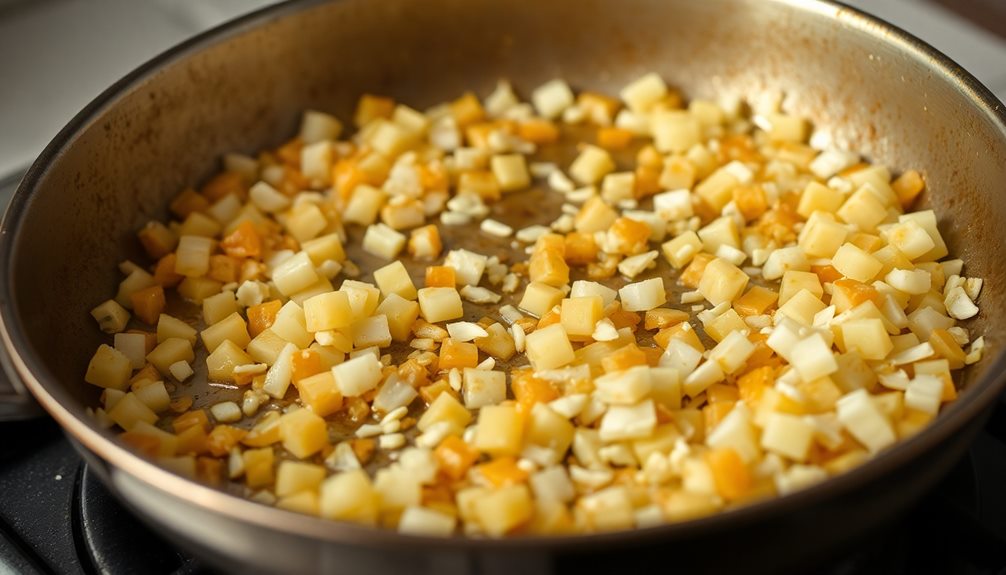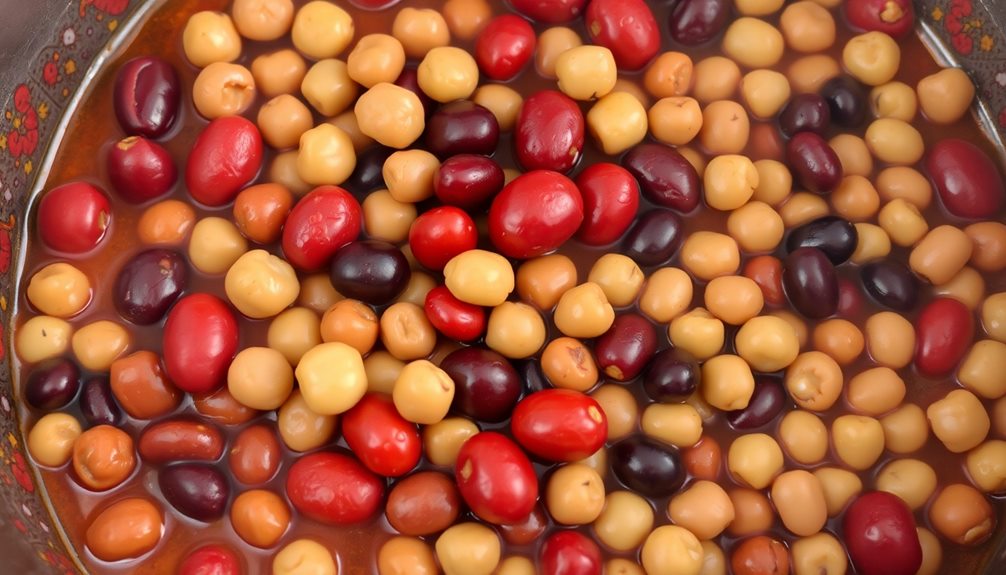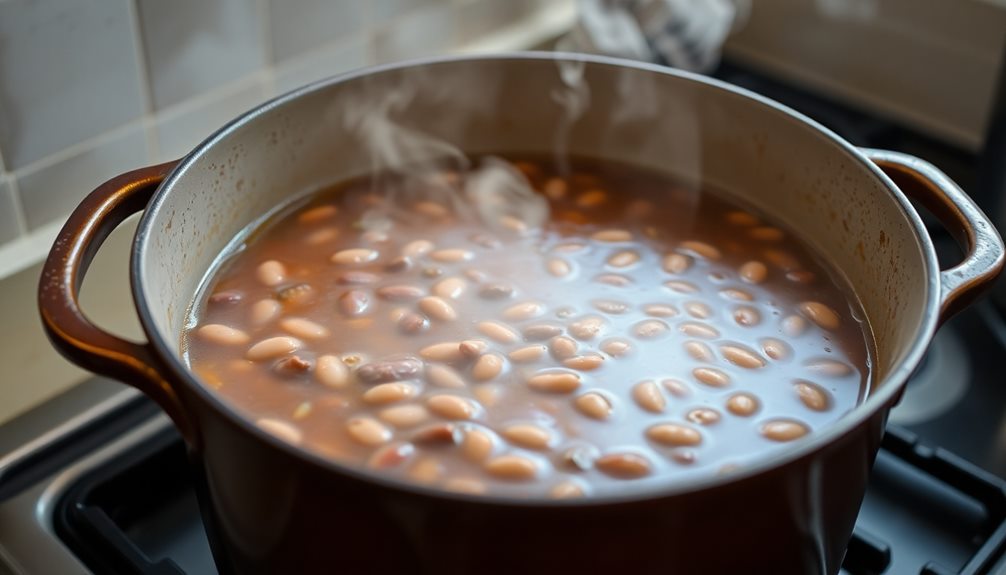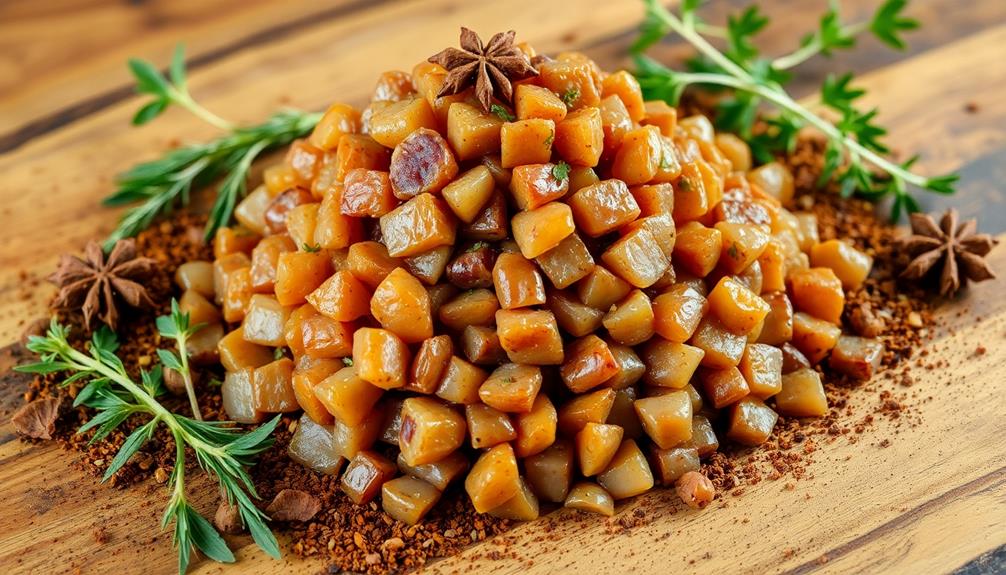Fasolia, Ethiopia's beloved bean stew, boasts rich, aromatic flavors perfected over centuries. You'll start by soaking dried beans overnight to soften them, then sauté fragrant onions, garlic, and spices like cumin and paprika in oil. Next, you'll add the beans, tomatoes, and more spices, simmering until the beans are tender. The result is a comforting, flavor-packed dish that showcases Ethiopia's vibrant culinary heritage. Serve fasolia with injera, rice, or couscous for a truly authentic experience. And if you're intrigued to learn more, keep reading to uncover the full recipe and cooking techniques.
Key Takeaways
- Fasolia is an Ethiopian bean dish with origins in the highland culinary traditions, featuring slow-simmered beans and regional variations.
- The dish is commonly served with accompaniments like injera, rice, or couscous, showcasing the vibrant and complex flavors of Ethiopian cuisine.
- The cooking process involves soaking dried beans, sautéing aromatics in oil, adding the beans, and simmering with tomatoes, garlic, and spices for a rich, flavorful base.
- The use of warm, earthy spices like cumin, coriander, and paprika, along with the long simmering time, contributes to the deep, complex flavors of the dish.
- Fasolia represents a culinary triumph of Ethiopian culture, with the dish's rich aromas and flavors creating a delightful dining experience and a lasting impression of traditional cooking mastery.
History

The origins of the Ethiopian bean stew can be traced back to the diverse culinary traditions of the Ethiopian highlands. For centuries, the people of this region have been perfecting the art of slow-simmered bean dishes, using a variety of beans and aromatic spices.
The stew, known as "fasolia," is a beloved staple in Ethiopian homes and restaurants. Over time, the recipe has evolved, with different regions and families adding their own unique twists. Some might include aromatic herbs, while others might experiment with different types of beans or a richer tomato-based broth.
What makes this stew so special is the depth of flavor it achieves through the slow cooking process. The beans become tender and infused with the fragrant spices, creating a comforting and satisfying dish.
Whether served with injera, the traditional Ethiopian flatbread, or alongside rice or couscous, fasolia is a true taste of the country's vibrant culinary heritage.
Cooking Steps

To begin, gather all the necessary ingredients. You'll need onions, garlic, tomatoes, spices like cumin and paprika, and of course, the star of the show – the beans! Don't forget the vegetable broth and a bit of olive oil too.
Now, let's get cooking! Start by sautéing the onions in the olive oil until they're soft and fragrant. Add the garlic and let it sizzle for a minute or two.
Next, toss in the tomatoes and let them simmer, breaking them down with a wooden spoon.
Time to introduce the spices! Sprinkle in the cumin, paprika, and any other seasonings you'd like. Stir everything together and let the flavors meld.
Finally, pour in the vegetable broth and add the beans. Let the stew simmer for about 20 minutes, allowing the beans to become nice and tender. Taste and adjust the seasoning as needed.
Serve this hearty Ethiopian bean stew over some fluffy injera bread or with a side of rice. Enjoy your delicious and authentic creation!
Step 1. Soak Beans Overnight, Drain

First, you'll want to soak the beans overnight. This helps them cook more quickly later on. Just place the dried beans in a large bowl and cover them with plenty of water.
They'll soak up a lot of liquid, so make sure there's at least 3 or 4 inches of water above the beans. Let them sit on the counter overnight, or for at least 8 hours.
In the morning, you'll see the beans have plumped up and the water level has gone down. Drain the beans in a colander, giving them a quick rinse. This gets rid of any dirt or debris.
Now your beans are ready for the next step in making this tasty Ethiopian stew. The soaking softens them up, so they'll cook faster and more evenly later on.
With this simple prep work done, you're on your way to a delicious, hearty meal!
Step 2. Sauté Aromatics in Oil

Now that you've prepared the beans, it's time to get the stew going. In a large pot or Dutch oven, heat a few tablespoons of oil over medium heat.
Once the oil is shimmering, add the chopped onions, garlic, and ginger. Sauté these aromatic ingredients, stirring frequently, until they're softened and fragrant, about 5-7 minutes.
Next, toss in the cumin, coriander, and paprika. These spices will infuse the oil with their warm, earthy flavors.
Stir everything together and let the spices toast for a minute or two, until you can smell their aroma wafting through the air. This step adds depth and complexity to the stew.
After the aromatics have developed, it's time to deglaze the pan. Pour in a splash of broth or water, scraping up any flavorful bits stuck to the bottom of the pot.
This will help build the foundation of the stew's rich, savory taste. Keep sautéing until the liquid has evaporated, about 2-3 minutes.
Step 3. Add the Beans

Finally, add the cooked beans to the pot. This is the moment you've been waiting for! Toss in those hearty, tender beans and watch them mingle with the aromatic flavors you've been building.
Gently stir the beans, making sure they're fully incorporated. You'll notice the stew thickening up as the beans release their starches. This is exactly what you want – a nice, chunky texture that'll stick to your spoon.
Don't be shy about adding a splash or two of the reserved bean cooking liquid. This flavorful liquid will help the beans seamlessly blend into the stew.
Taste as you go, adjusting the seasoning as needed. A pinch more salt, a sprinkle of spice – whatever your taste buds are craving.
At this point, your kitchen is likely filled with the most tantalizing aromas. Take a deep breath and let that Ethiopian magic wash over you.
You're well on your way to a belly-warming, soul-satisfying bowl of Fasolia!
Step 4. Add Tomatoes, Garlic, and Spices

Next, add the chopped tomatoes, minced garlic, and aromatic spices to the pot.
You'll want to use ripe, juicy tomatoes to add a burst of flavor. Mince the garlic cloves so they'll blend right into the stew. As for the spices, go with a blend of warm, earthy seasonings like cumin, paprika, and turmeric. These will give the stew its signature Ethiopian flair.
Stir everything together and let it all mingle for a few minutes. The tomatoes will start to break down, releasing their juices, while the garlic and spices will fill your kitchen with an incredible aroma.
This is where the stew really starts to come together, with the beans, vegetables, and seasonings melding into a rich, flavorful base. Keep an eye on it, stirring occasionally, until the flavors have had a chance to develop.
Soon, you'll be ready to add the final touches that will make this Ethiopian bean stew absolutely irresistible.
Step 5. Simmer Until Beans Are Tender

After adding the tomatoes, garlic, and spices, let the stew simmer gently until the beans are tender, about 20-30 minutes.
You'll know the beans are ready when they're soft and easily squished between your fingers. Gently stir the stew occasionally to prevent sticking or burning. The simmering process allows all the flavors to meld together, creating a rich, aromatic broth.
You'll be tempted to take a peek, but try to resist the urge – opening the lid too often can disrupt the simmering and slow down the cooking. As the minutes tick by, your kitchen will fill with the mouth-watering scent of this authentic Ethiopian dish.
Soon, you'll have a hearty, comforting stew that's perfect for sharing with family and friends. Don't be afraid to let it bubble away – the longer it simmers, the more intense the flavors will become.
Final Thoughts

The aromas and flavors of this Ethiopian bean stew linger, inviting you to savor each spoonful. The richness of the berbere spice blend, the creaminess of the beans, and the warmth of the stew come together in a truly delightful dish.
As you scoop up the final bites, you can't help but feel a sense of satisfaction and delight. This stew isn't just a meal; it's an experience. The layers of flavor, the soothing warmth, and the comfort it provides make it a dish you'll want to return to again and again.
Whether you're enjoying it on a cozy evening or serving it to your family, the Fasolia stew is sure to leave a lasting impression. As you savor the last few spoonfuls, you can't help but feel a sense of accomplishment.
You've mastered a traditional Ethiopian dish, bringing the rich culture and flavors of the country into your own home. This stew is a true culinary triumph, one that you'll be proud to share with your loved ones.
Frequently Asked Questions
What Is the Best Type of Beans to Use for Fasolia?
For the best type of beans to use, you'll want to go with a hearty, creamy bean like kidney, pinto, or cannellini. They'll hold their shape and soak up all the fantastic flavors in your dish.
Can Fasolia Be Made With Canned Beans?
You can certainly make fasolia with canned beans. While fresh or dried beans offer more depth of flavor, canned beans are a convenient option that can still result in a tasty dish.
How Long Does Fasolia Typically Take to Prepare?
Preparing this dish typically takes 30 to 60 minutes, depending on whether you're using canned beans or dried beans that need to be soaked and cooked. The exact time can vary based on the specific recipe and your cooking methods.
Can Fasolia Be Frozen and Reheated?
You can definitely freeze and reheat fasolia. The stew holds up well in the freezer, and reheats easily on the stovetop or in the microwave. Just be sure to let it thaw completely before reheating for best results.
What Are Some Common Accompaniments to Serve With Fasolia?
When serving this hearty bean dish, consider pairing it with some classic accompaniments like injera (Ethiopian flatbread), rice, or a side salad. You could also offer a dollop of yogurt or some crumbled feta cheese to complement the deep flavors.










